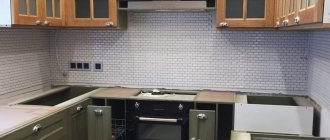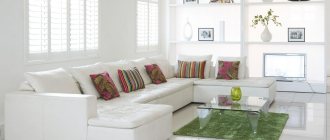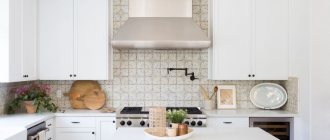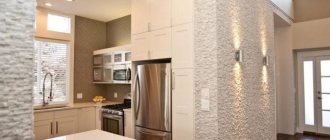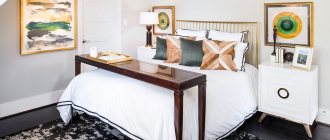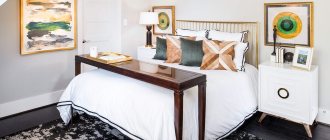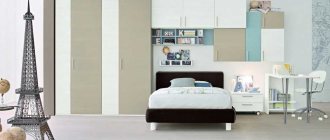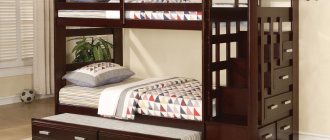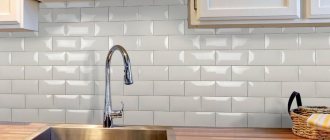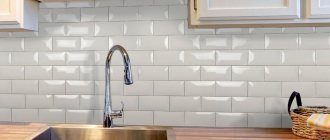The boar tile on the kitchen backsplash is a legacy of American Art Nouveau at the end of the 19th century. Initially, it was used as an economical imitation of brickwork on the facades of apartment buildings. In the original it had a natural brick fawn shade. This cladding was decorated with colored glossy glazed masonry.
It was first used as interior decoration in the French metro. Hence the name “metro”. Later, this version of the tile migrated to home interiors. “Boar” began to be called in Russian-speaking circles because of the two holes on the back of the part, reminiscent of a pig’s coin.
This cladding option is popular for its durability and external “correctness”. This is a thick, glazed rectangular tile with edges cut at an angle of 45 degrees (chamfer), imitating the composition of brickwork. The dimensions of one element (7.5*15 cm, 10*20 cm, 15*30 cm) correspond to the parameters of the side of the building brick.
Most designs use white and beige shades of masonry. The advantages include resistance to frequent washing, wear resistance, and impeccable appearance of the canvas (subject to high-quality masonry). High wear resistance allows frequent wet cleaning with detergents.
Key features of subway tiles you need to know before purchasing:
- Thick, heavy. This tile requires careful and expensive pre-installation preparation. However, the durability of the coating makes it popular for permanent use.
- Chamfer. This characteristic element of “brick” cladding will cause a lot of trouble when cutting and adjusting the joints.
- Difficulty cleaning. The convex texture makes the surface embossed with deep seams. This can cause inconvenience when cleaning the apron from dust and dirt.
Main dimensions of hog tiles
Kabanchik is a rectangular ceramic tile that resembles a brick.
Initially, it was used for cladding buildings, then it migrated to the walls of the subway, which is why in the USA and Great Britain it is called “subway”. The boar has three main sizes:
- small 7.5x10 cm;
- large 10x20 (10x30) cm;
- large 28.5x8.5 cm.
Since large tiles visually make small-sized kitchens smaller, a standard size of 10x20 cm is used for them. Any product is suitable for spacious rooms.
Original or imitation
The cost and the above-mentioned features of laying boar tiles make it possible to search for alternative methods of finishing the apron.
PVC panels, stylized as brickwork, are the most economical option. This has its own specifics. They cannot boast of durability. In addition, their appearance is far from the original.
The complexity of the preparatory stage and fastening of rather heavy elements may be a reason to prefer standard ceramic tiles without a chamfer. Modern manufacturers also offer ready-made tile carpets to match brickwork.
Boar tiles are not a temporary, but a permanent interior phenomenon. The high cost makes this finishing material a “forever” choice. Therefore, before going to the store, you should carefully study the possible colors, textures, sizes, and carefully consider the installation method.
Types of hog tiles
A distinctive feature of the hog is the chamfers - beveled edges running along the perimeter.
With chamfer
Chamfers (or facets) add volume to the product. The glazed surface looks especially impressive with them.
The photo shows a kitchen in chocolate shades, tiled with convex tiles with bevels.
Without chamfer
Flat products without a chamfer look laconic and are used if you do not want to overload the space with relief textures.
Styling tools
The hog finishing tiles are installed according to the principle of conventional ceramic tiles. To do this you will need the following tools and materials:
- Drill with kneading attachment and container;
- Rubber or plastic spatula, preferably flexible;
- Rubber mallet;
- Small construction float;
- Spatulas with teeth;
- Soft sponges and rags;
- Sharpening machine, tile cutter;
- Marking tool;
- Screws for fastening the profile;
- Metal or wooden profile;
- Tile adhesive, grout, water.
Tile backsplash color
Since the demand for boar is great, manufacturers are producing more and more new types of tiles, using the entire color palette, and also playing with textures, imitating natural materials.
White
This color remains popular due to its versatility. Ideally harmonizes with any shade, does not attract special attention, adding “air”.
The photo shows a kitchen with a white apron, originally located on the lower part of the wall.
Black
A deep black splashback is a bold and incredibly stylish way to highlight your workspace. The dark hog looks luxurious, but has a small drawback: any dirt is clearly visible on its glossy surface.
The photo shows a youth kitchen in which not only the apron is decorated with hog, but also the wall above the doorway.
Blue
Sky or dark blue tiles look original and add freshness to the interior.
Beige
An apron of a neutral shade fits well into a kitchen of pastel (milky, blue) tones. Sometimes it serves as a backdrop for bright furnishings.
Grey
Another universal apron color that is suitable for both light and dark kitchen facades.
Color
Color gives a kitchen its own character. A multi-colored apron will create a unique interior. And red will attract attention and create an atmosphere of hospitality.
Orange
If the kitchen lacks light and comfort, using an orange apron would be a great solution.
Yellow
The sunny yellow color of the apron adds cheerfulness to the interior or serves as a bright accent.
Green
Olive, pistachio, mint, light green – shades of green in the kitchen interior give a feeling of calm and natural harmony, and improve your mood.
The photo shows a kitchen with natural motifs. An olive splashback with a border harmonizes with the natural textures of the countertops and cabinets: marble and wood.
Lilac
This shade is rarely used for hog tiles. The lilac color gives the kitchen not only tenderness, but also uniqueness.
Useful tips
Tiles must be purchased with a reserve. It is about 10%. It always requires pruning, as a result of which part of it gets damaged. Before laying it is very important to level the wall, otherwise due to unevenness it will be difficult to lay out the tiles without flaws.
In addition, the service life of the hog directly depends on this preparation. The seams must be perfect, so it is better to trust a professional, especially if the layout is unusual.
It must be remembered that convex tiles are thicker and therefore heavier. Therefore, it must be attached more carefully, applying a larger layer of glue for standard material. The seams should be between 2 and 5 mm thick. Of course, the thicker it is, the better the look, but in this situation the complexity of the work increases.
Thus, boar tiles have won their rightful place in the kitchen interior. An apron made of this material has an attractive appearance, the originality of which depends on the laying of these bricks.
In addition, the material is very easy to wash. It is interesting that the seemingly soiled white color in this case, on the contrary, will be advantageous. This is because stains, possible drips and drops of water are invisible on such tiles. They are very easy to wipe with a regular damp cloth.
Regarding design, it is important that for any style it is possible to choose suitable hogs that will complement it and give the desired atmosphere. Manufacturers provide a wide selection of colors and patterns that are sure to suit any kitchen.
Apron design
A kitchen apron, lined with a hog pattern, can stretch along a corner or occupy the entire wall. Depending on the area allocated for it, various types of coatings and additional decor are selected.
If the set occupies the entire wall, it is recommended to use glazed products. The glossy finish effectively reflects light, visually expanding the space.
Hog with a matte finish is less common. It is used in interiors where gloss is stylistically inappropriate, or in kitchens with an abundance of shiny surfaces.
The photo shows a black kitchen, the glossy apron of which is favorably illuminated by built-in lamps.
The hog can easily be combined with other tiles, for example, when you need to highlight the area between the stove and the hood. The mosaic, inscribed in the apron with a thin strip, looks harmonious.
The photo shows a small kitchen, decorated with an emerald-colored apron and patterned tiles in the stove area.
You can also combine different colors and layout methods.
The advantages of such material
Boar tiles are perfect for a kitchen backsplash. This is due to many advantages of the material:
- Excellent sanitary and hygienic qualities. There is no accumulation or development of microorganisms, and thanks to the solid structure without pores, the tiles do not accumulate dirt, which makes them easy to clean.
- A varied selection of colors and pattern textures. In addition, it can be produced to order, decorated with an individual drawing or photograph. Therefore, the hog fits most interior styles.
- High temperature resistance. When making it, firing is used at about 1000 °C, so the tile is definitely not afraid of elevated temperatures from the stove.
- Simple installation technology that does not require expensive tools.
- The material is harmless and environmentally friendly , does not emit gases and does not cause allergies.
Boar tiles have almost no disadvantages. The only thing that can be noted is the relatively high price and low impact resistance.
Photo of tiles with a pattern
There are products, like regular tiles, that imitate natural textures: marble, brick.
A boar with an ornament, pattern or inscriptions is often found in the Scandinavian or Provence style.
Combinations
The boar is presented in the boldest and brightest colors. Natural colors - green, yellow, red, blue - are more often used in rustic styles, and non-natural shades - light green, purple, lilac - in more modern, industrial interiors.
How to choose a combination of several colors at once? Quite easy, you only need to select shades from one color spectrum. For example, blue. From this color you need to choose two supporting, lighter notes. Blue and light turquoise are ideal. Next, the tiles are laid in random patterns, balanced by color triangles.
strictly not recommended to use bright colors , for example, blue, green, red. If such a combination is still acceptable in the form of a mosaic, then a hog laid out in this way will ripple so much that the interior will become very difficult to perceive. In some cases it can lead to migraines and even loss of appetite.
The exception is monochrome color combinations - white, black and gray - such a combination can decorate any room.
If a large cluster of shades seems too heterogeneous, and a plain apron seems boring, you can choose something in between :
- Place a strip of a different color along the horizontal axis of the entire apron. For example, dilute a white boar with a black insert.
- Two parallel lines - along the countertop and under the upper cabinets with indentations in one row of tiles. This method will visually elongate the kitchen.
- For the random installation method, the option of a dedicated area near the hood is suitable. For example, a light green background can be diluted with a herbal shade, laid out from the hob to the very top.
Interesting article: How to choose an MDF kitchen apron?
Which grout should I choose for backsplash tiles?
First of all, it is worth considering its composition: grout based on epoxy resins, which is resistant to dirt, is best suited for the kitchen. If we talk about the palette, then for a plain neutral backsplash it is recommended to choose a grout that is similar in color to the tile itself. White and gray grout are considered universal.
The photo shows a burgundy-colored apron with matching grout, which “dissolves” the seams without focusing attention on them.
If you need to make an accent apron, you can use contrasting combinations. For example, black grout on white tiles will add a graphic touch to the interior. If the tiles are dark, white joints will highlight the texture or interesting shade.
The photo shows an example of contrasting grout. Without it, the wall above the work area would look empty and unfinished.
Why is it called that?
The question “What is this?” often occurs to people when a designer starts talking about a pig in the kitchen.
This tile is called this way only in Russian-speaking countries. This is due to the tile manufacturing process: its blank at the end has two holes that resemble the heels of a pig. The nickname passed from production to the people, and it stuck.
In the West, this tile is called “Metro”. As the name suggests, it is installed in the subway and other public places because it looks simple and neat. Initially, buildings were lined with boar, then metro crossings. Unfortunately, information about who began to use it to decorate the house has not been preserved.
Boar tile layout options
If you use plastic panels that imitate a hog, there will be only two cladding options: vertical and horizontal. But the rectangular shape of the individual tile elements allows you to lay it in several ways:
- Vertical with offset. A method by which you can visually lengthen a tiled wall.
- Horizontal staggering. The most common option is when the tiles are laid offset, like a brick.
- Horizontal stackable. A neat seam-to-seam method with an emphasis on geometric accuracy.
- Vertical stackable. A method designed to emphasize the severity of lines in the interior.
- Diagonally. The elements are placed at an angle of 45°. This option is suitable for small kitchens, as it visually expands the apron area.
- Herringbone. The tiles are laid in a zigzag pattern to create a beautiful pattern.
The photo shows a black vertical hog, adding respectability to the interior.
Peculiarities
The second name – “metro” – was given to the tiles in the West, where metro stations are lined with material similar in configuration. Indeed, the shape of the hog resembles bricks, which are presented in two configurations :
- With beveled edges - a small bevel that makes the kitchen apron embossed and textured.
- Absolutely flat tiles that form a smooth, unified structure.
Glazed ceramic tiles in the form of bricks are used everywhere due to the variety of style solutions.
How does a boar apron look in different interior styles?
Hog tiles are so multifunctional that they will fit into any interior.
Provence (“French country”) combines rustic simplicity and sophistication. The apron can have a pattern or, conversely, act as a backdrop for cozy little things and an antique set.
White tiles will fit into a spacious loft with rough textures, which will serve as a contrast to industrial furniture. An interesting option is when the smooth glossy coating of the apron echoes the textured brickwork.
Due to its laconic shape, the boar will harmoniously fit into both modern and Scandinavian kitchen styles.
The photo shows a kitchen in a modern direction with herringbone tiles.
In the classic style, a beige hog will find its application, highlighting the splendor of a luxurious set and rich decorative elements.
Advantages
Boar tiles are just perfect for a kitchen backsplash. This is due to a number of its advantages:
- resistance to frequent washing;
- wear resistance;
- aesthetics;
- ease of cleaning;
- variety of color and texture variations;
- resistance to high temperatures;
- ease of installation;
- safety and environmental friendliness.
This material has practically no disadvantages. We can only highlight the relative high cost and low impact resistance.
Advantages and disadvantages
Like any other material, boar has its advantages and disadvantages. The obvious advantages include the following:
- Boar is a very durable and reliable material. The service life is tens of years.
- A large selection of shapes and colors, allowing you to implement any design solution.
- Style diversity.
- The opportunity to make a bright and original accent in a measured interior.
- Easy care.
minor drawback is the presence of seams, where dirt accumulates over time.
